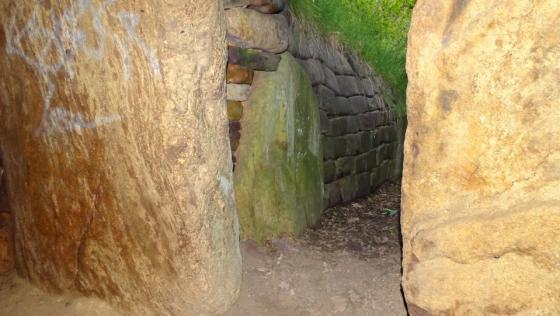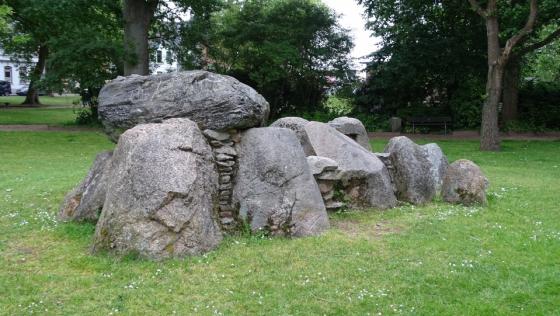taken from the on-site information board:
A megalithic tomb
on the Brutkamp in Albersdorf, district Dithmarschen
This large stone grave (also called megalithic tomb, mega=large, lithos=stone) is located on a slight natural elevation in the village of Albersdorf.
At Brutkamp the burial chamber consists of five support stones and a capstone weighing almost 23 tons – the largest in Schleswig Holstein. In technical terminology, this type of tomb is called a polygonal dolmen, a special form; here the supporting stones form a polygonal layout.
The entrance to the burial chamber with three remaining support stones is in the southeast. In the vicinity of the entrance there were several broken stones, one of which is to be regarded as the capstone of the corridor. This stone had a series of round indentations on one side – so-called cup marks. The mound of earth covering the megalithic tomb has been almost completely removed or eroded.
Investigations by the Institut für Ur- und Frühgeschichte der Universität Kiel took place in the summer of 2009, and numerous ceramic and flint finds came to light. Most likely, the entrance area was destroyed as early as the late Neolithic.
In Schleswig-Holstein, the oldest graves that can be reliably dated belong to the early Stone Age, called Neolithic by experts (4,100-1,700 BC). Those numerous tombs, which were erected in the period between 3,500-3,000 BC have shaped our landscape for thousands of years until today. They are built from the large boulders (mostly granite) left by the Ice Age glaciers. These graves were mostly community (collective) graves in which numerous dead were buried over a long period of time. Typical additions were clay pots, axes, chisels and arrows made of flint or jewelry made of amber.
People no longer lived from hunting and gathering food. They had become sedentary farmers who ran cattle and fields.
In the past, the megalithic tombs were not considered human work. Nobody could imagine that such large and heavy stones could be moved by people. Many sagas and legends are entwined with these imposing tombs and they were viewed as the work of the devil, the witches and also the giants. According to tradition, the newlyweds made a sacrifice to the Nordic goddess Freya (goddess of fertility and love) here at Brutkamp. The Brutkamp megalithic tomb characterizes the coat of arms of the municipality of Albersdorf.











